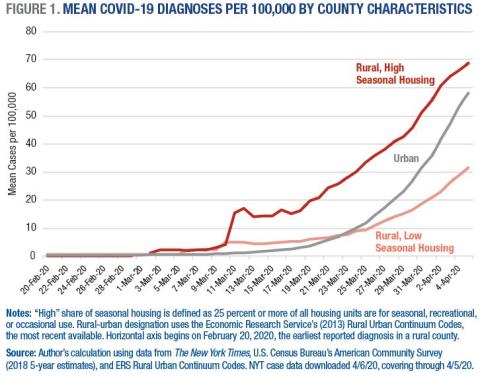download the brief
Key Findings

In rural counties with high shares of seasonal housing, average cases of COVID-19 per 100,000 are twice as high as in other rural places.
UPDATE (4-29-20)—Case data through April 27, 2020 indicate that the gap between rural counties with higher and lower shares of seasonal housing has essentially closed. While cases per 100,000 have continued to rise in both kinds of places, the shrinking gap is largely attributable to rising rates in rural places with less seasonal housing, as fewer communities are left untouched by COVID-19. Urban cases per 100,000 outstripped both kinds of rural counties as of April 9, 2020.
As the pandemic escalates, rural counties with high shares of seasonally vacant housing are seeing higher rates of COVID-19 cases than either urban or other rural areas. In the nation’s 199 rural counties where seasonal housing accounts for 25 percent or more of all housing units, average cases per 100,000 are more than twice as high as in other rural counties and 15 percent higher than in urban areas as of April 5 (Figure 1). This is consistent with anecdotal reports of hot spots in popular vacation locations as visitors, including some who are unknowingly infected, exit urban areas attempting to socially distance at second homes and seasonal rental properties. There are, however, several possible explanations for the higher prevalence of cases including differences in the level of testing and the higher median age seen in these areas.

Jess Carson is a research assistant professor with the Vulnerable Families Research Program at the Carsey School of Public Policy. Since joining Carsey in 2010, she has studied poverty, work, and the social safety net, including policies and programs that support low-income workers like affordable health insurance, food assistance programs, and quality child care.
